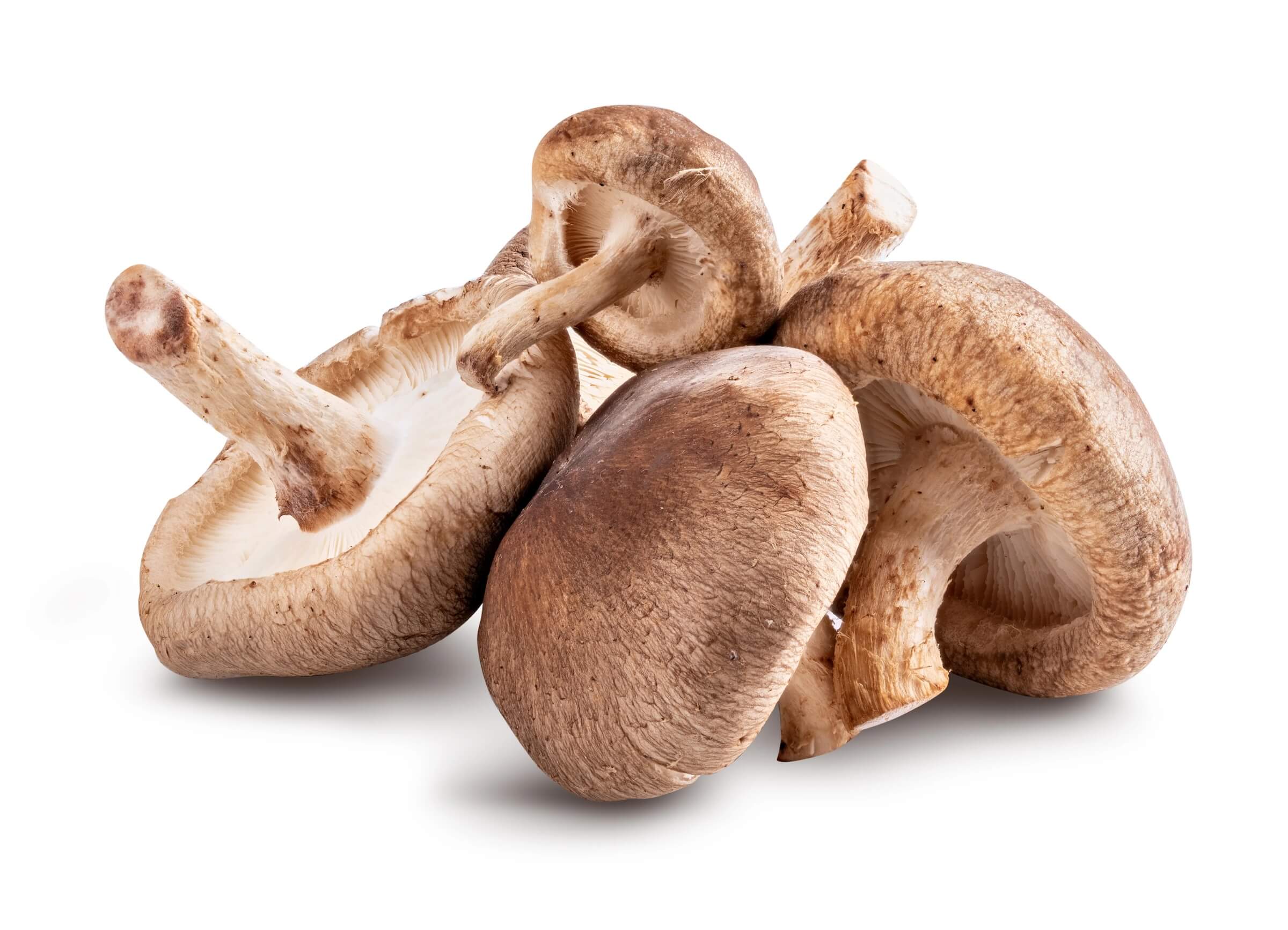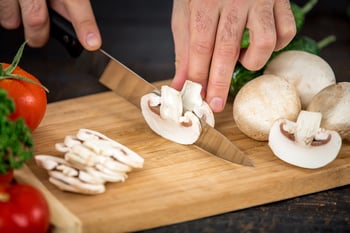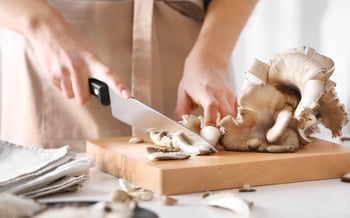Ah, the magnificent mushroom. This often-forgotten fungus is one of nature’s finest dietary resources, with many varieties of edible mushrooms for the choosing— all with their own unique taste profiles and health benefits.
If you’re curious to learn about some of the most delicious types of mushrooms found at your local grocer, you’re in the right place. Let’s compare a few varieties to help you expand your dining options:
White Button 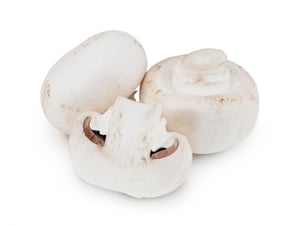
Chances are, if you’re at the grocery store and see a white-colored mushroom, it’s a White Button! That’s because White Button mushrooms are by far the most popular mushroom variety, representing 90% of mushrooms consumed in the United States, according to The Mushroom Council.
Identifying White Buttons
White Button mushrooms have the classic appearance of the everyday round-top mushroom. They have short, thick stalks and a distinct white cap about the size of a half-dollar.
The Taste of White Buttons
All mushrooms are known for their unique flavor profile, referred to as “umami.” It’s that fifth taste on the tongue that’s often missed behind sweet, salty, sour and bitter.
Umami is often described as robust and rich— reminiscent of meat— with a hint of saltiness. Different mushroom varieties all have unique strengths of umami on the palate.
Compared to edible brown-hued mushroom varieties, White Buttons often have a more mild flavor, especially when consumed raw. When in a fresh-picked state, they have a light earthy flavor with a firm yet rubbery texture. While cooking White Buttons intensifies their flavor, they are still considered the mildest retail mushroom.
What to Eat with White Buttons
White Button mushrooms are often consumed raw more than cooked. In fact, they’re a popular go-to on salads. Here’s some on our tasty Marinated Mushroom 7-Layer Salad recipe, for example.
They’re also a hit when sautéed or roasted and paired with pasta, pizza, and main dishes, especially on top of chicken, turkey, and pork. Try our Three Mushroom & Garlic Grilled Pizza recipe to see for yourself!

The Health & Nutritional Benefits of White Buttons*
One serving (5 medium mushrooms) is an excellent source of the B vitamins riboflavin (28% DV), niacin (20% DV), and pantothenic acid (27% DV), while also providing copper (32% DV) and 2.8mg of ergothioneine.
Baby Bella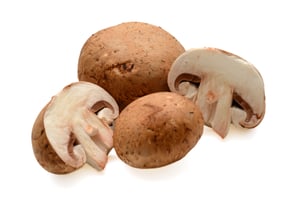
Another one of the most common types of mushrooms you’ll find in almost any grocery store is the Brown mushroom, formally known as Baby Bella. They also go by a few other names, such as Cremini, Mini Bella, Baby Portabella, and Portabellini.
Identifying Baby Bellas
Baby Bella mushrooms are similar in appearance to Whites in shape and texture, except these Brown mushrooms have a light tan to rich brown cap and a firmer texture.
The Taste of Baby Bellas
Brown mushrooms have a deeper, earthier flavor than Whites Buttons. This flavor is especially pronounced when cooked, adding a bold, robust touch that pairs exceptionally well with many meats. Because Baby Bella caps are firmer, they add dimension to a dish (even sometimes served as their own side and not just a topping) and can create a hearty feeling in the mouth while chewing.
What to Eat with Baby Bellas
The full-bodied taste of Brown mushrooms makes them the perfect complement to beef, wild game and vegetable dishes. Experiment cooking with Baby Bellas by trying our easy Classic Hamburger with Sauteed Mushrooms or our Blended Green Bean Casserole.
Baby Bellas are also often used in lieu of meat to mimic its robust taste and filling density. A prime example is our Goat Cheese Pancetta Stuffed Mushrooms, which makes for either an excellent appetizer— or even— a main course!
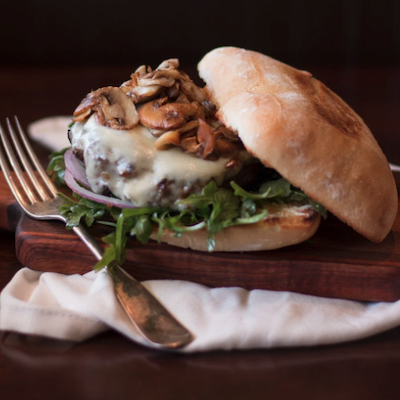
The Health & Nutritional Benefits of Baby Bellas*
Four Baby Bella mushrooms (one serving) are an excellent source of copper (44%), selenium (38%) and B vitamins riboflavin (30%) and pantothenic acid (27%); they additionally provide 4.9mg of ergothioneine.
Portabella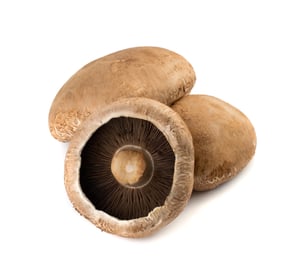
Another popular mushroom in almost every produce department is called the Portabella, sometimes spelled “Portabello” or referred to as Portabellini. They’re the largest of the domestic edible mushrooms, according to Mushrooms Canada.
Identifying Portabellas
Baby Bellas get their name as the “baby” version of the Porta”bella.” Ports are simply a more maturely harvested Bella, boasting larger caps that measure up to six inches in diameter. Just like the Baby Bellas, Portabellas are tan or brown in color, just bigger!
The Taste of Portabellas
Because Portabella mushrooms grow larger than Baby Bella, they lose some moisture. This gives them a thicker, more meat-like texture and deeper flavor. This is often why Portabellas are cut into long slices and served as Portabella “steaks,” acting as a stand-alone substitute for meat.
What to Eat with Portabellas
Ports can be grilled or roasted and served primarily as a side or the main dish. In these Portabella Pan Fajitas or Portabella Philly Cheesesteaks, for instance, the mighty mushroom completely replaces the meat in the wraps. While in this other creative recipe, we served them alone breaded with Panko as Portabella Fries.
Because Ports are such a thick cap, they can hold and soak up liquid, making them a not-so-secret grill favorite! Whip up your favorite marinade and give them a good roast.
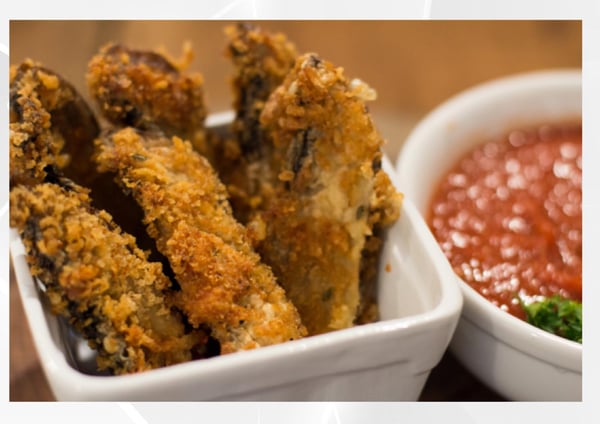
The Health & Nutritional Benefits of Portabellas*
One medium-size Portabella (3 oz) is an excellent source of copper (27%), selenium (28%) and niacin (24%), and contains 4.3mg of ergothioneine.
Shiitake
Ready to branch out and try specialty mushrooms? The Shiitake acts as the perfect training wheels to transition from more traditional Brown mushrooms such as Baby Bellas and Portabellas to a different kind of fungi.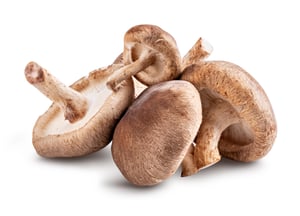
Identifying Shiitake
While at a quick glance Shiitake mushrooms do look similar to Baby Bellas, they have their noticeable differences when you really examine them. Sure, Shiitake mushrooms are also tan to dark brown in color, but Shiitake have broad, umbrella-shaped caps, wide open veils, tan gills, and long, curved stems (which should be removed prior to eating).
The Taste of Shiitake
Unlike Portbellas which have a more meaty texture, Shiitake are softer, with a more fleshy “skin.” Wherein Baby Bellas and Ports have a robust, distinct umami taste, Shiitake mushrooms have a more smokey or woody flavor profile.
What to Eat with Shiitake
Because of their origin in East Asia, they are often paired with the tastes of Asian cuisine as a way to add a unique smokey mouthfeel. Our Shiitake & Smoked Tofu Stir Fry is a prime example of the perfect blend of flavorful Tamari with this woody wild mushroom. Shiitake also tastes fantastic in warm soups. Try our Asian Mushroom Matzo Ball Soup recipe to see what we mean.
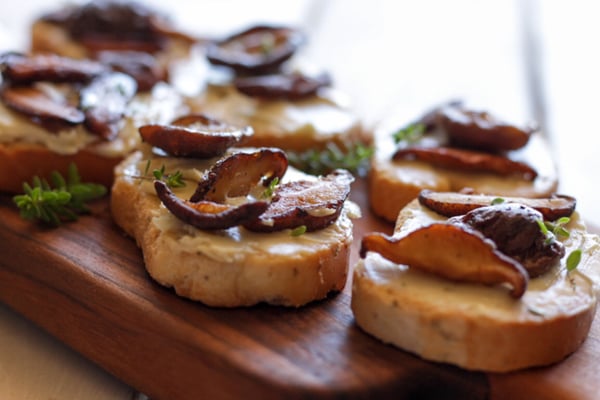
The Health & Nutritional Benefits of of Shiitake*
Four whole raw Shiitake are a good source of riboflavin (13%) and copper (12% in addition to providing a healthy dose of pantothenic acid (23%).
New to Eating Mushrooms?
If you’re curious to learn more about the dietary benefits of incorporating fresh fungi into your meals, we have a great resource for you!
In our Nutrition Guide for Foodies, we dig deeper into the nutrition facts of mushrooms and introduce you to 12 ways to cook with them, even including some mouthwatering recipes. Download it for free, today.
*All mushroom health and nutritional benefits courtesy of The Mushroom Council. For information on Monterey Mushroom’s products, review our Fresh Mushroom Nutrition Facts.

